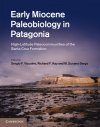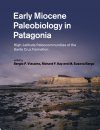By: Sergio F Vizcaíno(Editor), Richard F Kay(Editor), M Susana Bargo(Editor)
370 pages, 125 b/w photos, illustrations and maps; 41 tables
![Early Miocene Paleobiology in Patagonia Early Miocene Paleobiology in Patagonia]()
Click to have a closer look
About this book
Contents
Customer reviews
Biography
Related titles
About this book
Coastal exposures of the Santa Cruz Formation in southern Patagonia have been a fertile ground for recovery of Early Miocene vertebrates for more than 100 years. Early Miocene Paleobiology in Patagonia presents a comprehensive compilation of important mammalian groups which continue to thrive today. It includes the most recent fossil finds as well as important new interpretations based on 10 years of fieldwork by the authors. A key focus is placed on the paleoclimate and paleoenvironment during the time of deposition in the Middle Miocene Climatic Optimum (MMCO) between 20 and 15 million years ago. The authors present the first reconstruction of what climatic conditions were like and present important new evidence of the geochronological age, habits and community structures of fossil bird and mammal species. Academic researchers and graduate students in paleontology, paleobiology, paleoecology, stratigraphy, climatology and geochronology will find this a valuable source of information about this fascinating geological formation.
Contents
List of contributors
Preface
1. Background for a paleoecological study of the Santa Cruz Formation (late Early Miocene) on the Atlantic Coast of Patagonia
2. Tephrochronology of the Santa Cruz and Pinturas Formation
3. Tephrochronology and paleontology of the Santa Cruz and Pinturas Formation
4. Sedimentology and paleoenvironment of the Santa Cruz Formation
5. Oysters from the base of Santa Cruz Formation (late Early Miocene) of Patagonia
6. Ichnology of the Santa Cruz Formation (late Early Miocene), at the coast between the Rio Gallegos and Rio
7. Fossil plant studies from late Early Miocene of the Santa Cruz Formation: paleoecology and paleoclimatology at the passive margin of Patagonia, Argentina
8. Amphibians and squamate reptiles from the Santa Cruz Formation (late Early Miocene), Santa Cruz Province, Argentina: paleoenvironmental and paleobiological considerations
9. Diversity and paleobiology of the Santacrucian birds
10. Paleoecology of the Paucituberculata and Microbiotheria (Mammalia, Marsupialia) from the late Early Miocene of Patagonia
11. Paleoecology of the mammalian carnivores (Metatheria, Sparassodonta) of the Santa Cruz Formation (late Early Miocene)
12. Paleobiology of Santacrucian glyptodonts and armadillos (Xenarthra, Cingulata)
13. Paleobiology of the Santacrucian sloths and anteaters (Xenarthra, Pilosa)
14. Paleobiology of Santacrucian native ungulates (Meridiungulata: Astrapotheria, Litopterna and Notoungulata)
15. Paleobiology of Santacrucian Caviomorph rodents: a morpho-functional approach
16. The paleobiology of Santacrucian primates
17. A review of the paleoenvironment and paleoecology of the Miocene Santa Cruz Formation
Index
Customer Reviews
Biography
Sergio F. Vizcaíno is Professor of Vertebrate Zoology at the Universidad Nacional de La Plata (Argentina) and a researcher of the Consejo Nacional de Investigaciones Cientificas y Tecnicas working at the Museo de La Plata. His research focuses on the paleobiology of South American fossil vertebrates, mostly mammals, and he has authored approximately 100 research papers and book chapters and edited one book and several special volumes. Professor Vizcaino has participated in numerous fieldwork seasons in Argentina and Antarctica. He was the President of the Asociacion Paleontologica Argentina and in 1996 and 2008 he won awards for his publications in Ameghiniana, the journal of the APA.
Richard F. Kay is Professor of Evolutionary Anthropology and Earth and Ocean Sciences at Duke University, North Carolina, where he has worked since 1973. He has edited six books and authored more than 200 research papers on primate paleontology, functional anatomy, adaptations and phylogenetics. Professor Kay has conducted paleontological field research in seven South American countries since 1982 and is an elected fellow of the American Association for the Advancement of Science.
M. Susana Bargo is a vertebrate paleontologist at the Division Paleontologia Vertebrados of the Museo de La Plata, Argentina, and a researcher for the Comision de Investigaciones Cientificas de la Provincia de Buenos Aires. Her research focuses on the paleobiology of South American fossil mammals. Dr Bargo has authored about 50 scientific papers and book chapters and was the editor in charge of vertebrates for Ameghiniana, winning an award in 2008 for a publication in that journal. She has participated in numerous field seasons in Patagonia, Argentina.
By: Sergio F Vizcaíno(Editor), Richard F Kay(Editor), M Susana Bargo(Editor)
370 pages, 125 b/w photos, illustrations and maps; 41 tables
"Recommended. Upper-division undergraduates through professionals."
– E. Delson, Choice
"The massive collaborative effort of scientists from so many locations and institutions to produce this book must be commended and celebrated. This publication is a must for any student of South American vertebrate palaeontology."
– Aryeh Grossman, The Quarterly Review of Biology



































